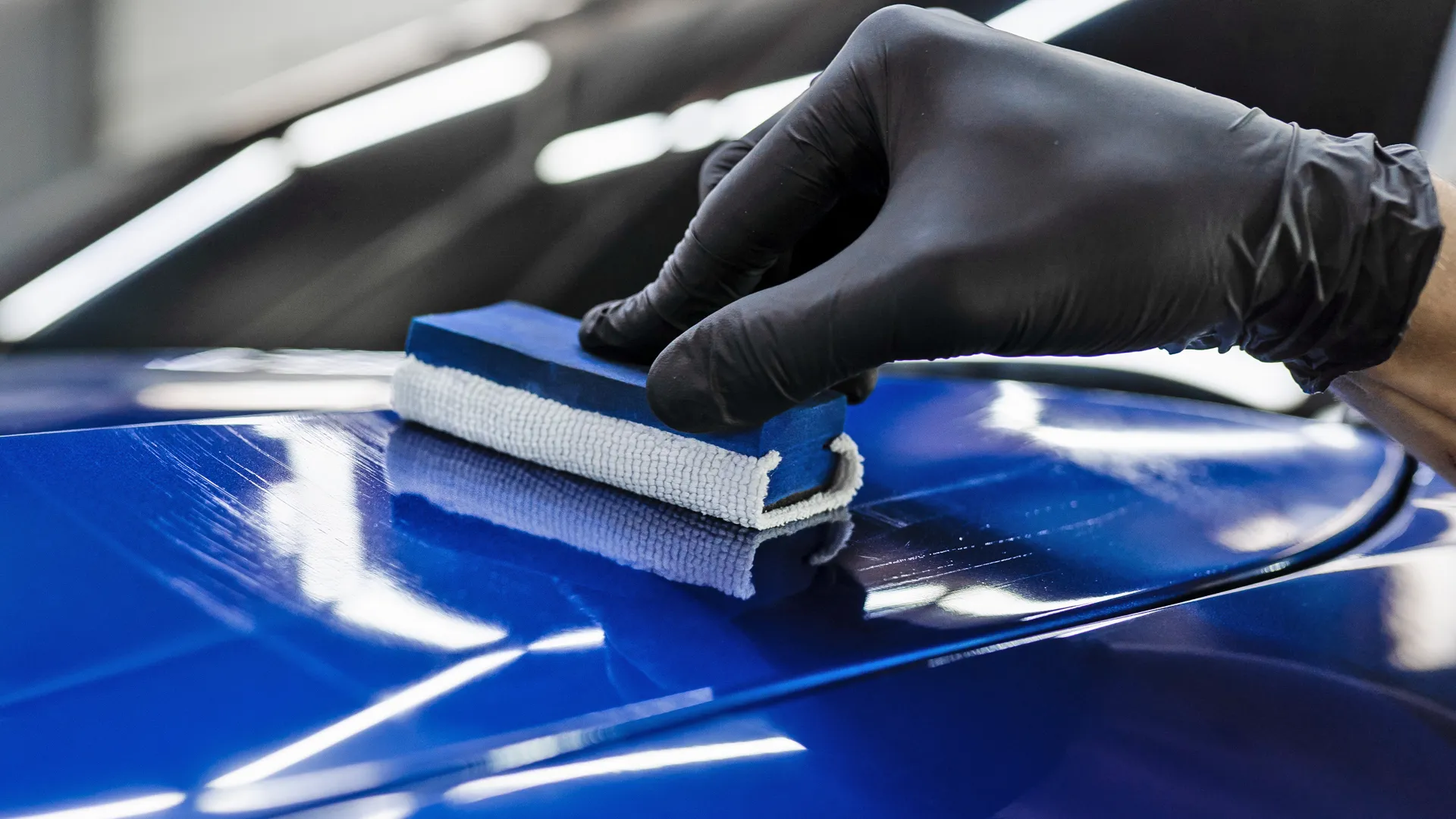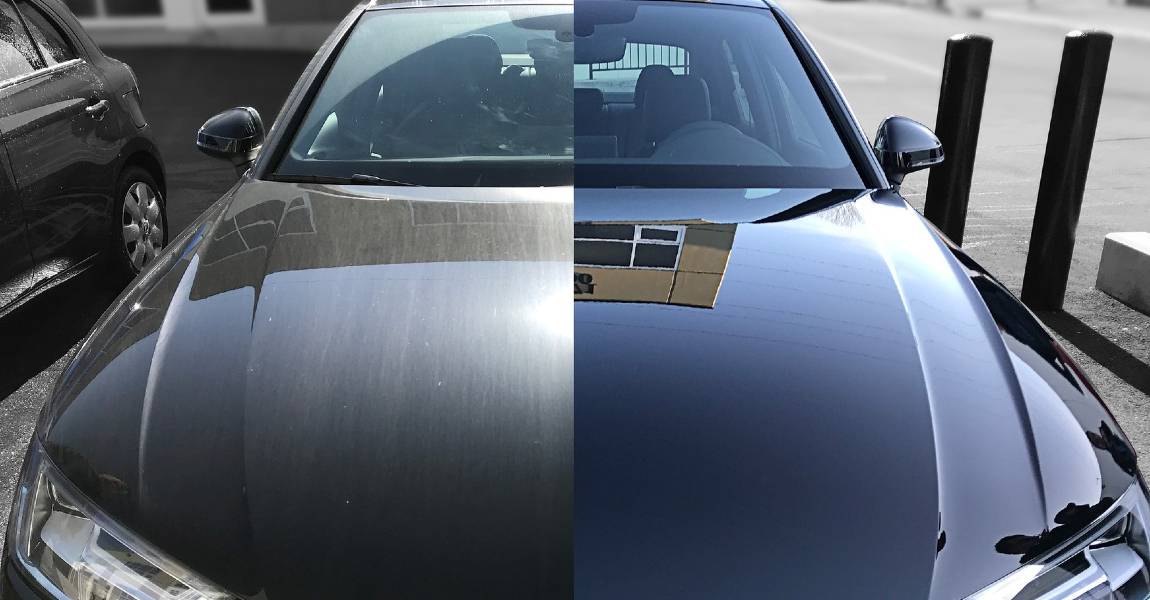The most common mistakes to avoid with Ceramic Coating Newark
Discovering the Scientific Research Behind Car Ceramic Coating and Its Safety Features
The scientific research of car ceramic coating presents an interesting research in innovative automotive protection. Composed mainly of silicon dioxide and polymers, these coatings form a robust bond with car paint. This communication boosts durability versus environmental dangers while using hydrophobic benefits. Nevertheless, the details of how these coverings job and their long-lasting advantages stay less comprehended. Unpacking these details reveals why ceramic finishings are ending up being a recommended selection for lorry treatment
What Is Ceramic Coating?
Ceramic coating is a fluid polymer that chemically bonds to the surface area of a lorry's paint. This innovative safety layer boosts resilience and provides superior resistance to environmental variables. Unlike traditional wax or sealers, which supply temporary protection, ceramic coverings produce a lasting shield that can hold up against severe conditions such as UV rays, acidic impurities, and extreme weather. When used properly, the coating creates a hydrophobic surface, causing water to grain and slide off, which helps in keeping the automobile's tidiness. In addition, it offers enhanced gloss and depth to the paint, making the automobile show up even more refined and vivid. The application process usually includes complete surface prep work, including cleansing and sprucing up, to assure peak bonding. Consequently, ceramic finishings are becoming progressively preferred among car fanatics and those seeking to shield their investments, assuring to maintain the car's visual charm while decreasing the frequency of maintenance.
The Composition of Ceramic Coatings
The complex formula of ceramic finishes mainly consists of silicon dioxide (SiO2), which is stemmed from all-natural resources like quartz and sand. This essential element provides the structure for the coating's durability and safety top qualities. Along with SiO2, ceramic finishes often include different polymers and additives that improve attachment, flexibility, and resistance to ecological factors. These substances function synergistically to develop a robust obstacle versus contaminants such as dust, chemicals, and UV rays.Furthermore, some solutions integrate titanium dioxide (TiO2) or other nanomaterials, which can increase the coating's hydrophobic residential or commercial properties, resulting in better water repellency. The precise composition can vary substantially amongst producers, affecting efficiency and durability. Ultimately, the combination of these components culminates in a safety layer that not only enhances the visual appeal of cars but additionally serves to lengthen their life expectancy by shielding the surface from possible damages.
Exactly How Ceramic Coatings Work
Comprehending exactly how ceramic finishes work entails exploring their chemical composition, which adds to their safety top qualities. The application process is essential for achieving ideal outcomes, while long life and toughness aspects figure out the coating's efficiency in time. With each other, these elements highlight the benefits and efficiency of ceramic finishes for car protection.
Chemical Make-up Explained
While lots of car owners look for durable defense for their cars, the chemical composition of ceramic layers plays a vital function in their performance. These finishings largely are composed of silicon dioxide (SiO2), which is originated from all-natural minerals. This compound develops a strong bond with the lorry's paint, developing a durable, protective layer. Furthermore, many ceramic coverings have titanium dioxide (TiO2), enhancing their hydrophobic homes and resistance to UV rays. The presence of polysiloxanes can additionally improve flexibility and resilience. With each other, these elements add to the coating's ability to push back water, dust, and impurities, while additionally giving a high-gloss coating. Recognizing this chemical structure assists car proprietors value the durable protection used by ceramic coatings.
Application Process Introduction
Using ceramic coatings includes a careful procedure that guarantees optimal bonding and defense for the lorry's surface. Detailed cleansing and decontamination of the car's outside are done to remove dirt, crud, and previous waxes. This action validates that the surface area is devoid of pollutants that might impede bond. Following this, the paint is commonly brightened to boost clearness and get rid of any blemishes. As soon as prepared, the ceramic coating is used in tiny areas using an review applicator pad, permitting consistent protection. The coating is then delegated treat, developing a strong chemical bond with the surface. Correct healing times and problems are critical, as they verify the coating achieves its optimum performance and protective high qualities.
Durability and Toughness Factors
Ceramic layers are designed to provide resilient security via their sophisticated chemical make-up, which creates a durable obstacle against environmental impurities. The durability of these coatings is affected by aspects such as the thickness of the application, the quality of the product, and the problems under which the car is exposed. High-grade ceramic finishes can last a number of years, resisting scrapes, UV rays, and chemical discolorations. Proper maintenance, including normal cleaning and periodic reapplication, can even more improve long life. Furthermore, environmental variables like climate and direct exposure to contaminants can influence the life expectancy of the coating. Overall, when used and maintained appropriately, ceramic finishings offer phenomenal toughness, making them a popular option for car enthusiasts looking for to maintain their car's look.
Hydrophobic Properties and Water Repellency
Hydrophobic properties are a hallmark of quality car ceramic finishings, significantly enhancing the automobile's surface area efficiency. These finishes produce a molecular bond with the car's paint, leading to a surface area that repels water successfully. When water enters into contact with a ceramic-coated surface, it grains up and rolls off, decreasing the amount of liquid that remains on the paint. This habits not only adds to a cosmetically pleasing look but likewise decreases the accumulation of impurities such as dirt, crud, and road salts.The boosted water repellency results in easier cleaning and upkeep, as much less effort is needed to eliminate undesirable materials. On top of that, the hydrophobic nature of ceramic finishings helps in preventing water spots, which can mar the finish of uncoated surface areas. On the whole, the incorporation of hydrophobic residential properties in ceramic coverings plays a crucial function in maintaining the vehicle's beautiful look while simplifying upkeep.
Protection Against Scratches and UV Damages
Car ceramic coatings offer substantial protection versus scrapes and UV damages. The scratch resistance mechanism creates a durable layer that soaks up influences, while the UV securing advantages assist maintain the lorry's paint stability gradually. Together, these attributes contribute to a longer-lasting and aesthetically appealing surface.
Scrape Resistance Device
Making use of innovative innovation, ceramic coverings give a durable shield versus scratches and UV damages, improving the longevity and look of car surface areas. The scratch resistance mechanism of these coatings is credited to their unique molecular framework, which forms a sturdy bond with the car's paint. This bond creates a hard, safety layer that can absorb influences and resist abrasions. In addition, the smooth surface of the coating lowers rubbing, making it challenging for impurities to stick and cause scratches. The chemical structure of ceramic finishes frequently consists of nanoparticles that reinforce the safety layer, more boosting its strength. Lorries treated with ceramic coverings display noticeably enhanced scrape resistance compared to conventional wax or sealants, guaranteeing an excellent surface over time.
UV Shielding Advantages
The protective top qualities of ceramic coatings expand beyond scratch resistance to include significant UV securing benefits. These coverings develop a durable barrier that mirrors dangerous ultraviolet rays, protecting the vehicle's paint and underlying materials. Long term direct exposure to UV radiation can cause fading, oxidation, and wear and tear of the paint coating. By including ceramic finishes, car owners can successfully alleviate these dangers, preserving the visual charm and integrity of their cars and trucks. Additionally, the UV obstructing buildings add to improved long life, decreasing the frequency of painting and upkeep. Ultimately, the combination of ceramic coverings supplies website here a detailed option for protecting vehicles from the destructive effects of sunlight exposure, making sure a sustained, lively appearance in time.
The Durability and Upkeep of Ceramic Coatings

Often Asked Concerns
Can Ceramic Coating Be Applied to Any Type Of Kind Of Car?
Ceramic coating can be used to different kinds of lorries, consisting of vehicles, trucks, and motorcycles. Nevertheless, surface preparation and compatibility with particular materials are vital for optimal adhesion and efficiency of the coating.
Just How Much Does Ceramic Coating Commonly Price?
Ceramic coating normally sets you back between $500 and $2,000, depending on factors such as automobile size, coating quality, and professional application. The financial investment can provide durable defense and boost the lorry's look gradually.

Is Specialist Application Needed for Best Results?
The necessity of expert application typically depends on preferred results. Specialists generally assure correct surface area preparation and application strategies, bring about suitable bonding and durability of the coating, which may be challenging for inexperienced people to accomplish.
Can Porcelain Coatings Be Gotten Rid Of or Repaired?
Ceramic coatings can be removed or fixed, though the process might need specific solvents or strategies - Ceramic Coating Newark. Correct removal is important to stay clear of damage to the underlying surface area, highlighting the significance of specialist help for perfect outcomes
How Does Porcelain Coating Compare to Standard Wax?
The comparison in between ceramic coating and standard wax exposes that ceramic coatings use premium durability, improved defense against environmental pollutants, and longer-lasting sparkle, while wax calls for a lot more constant application and offers less overall resistance to damages.